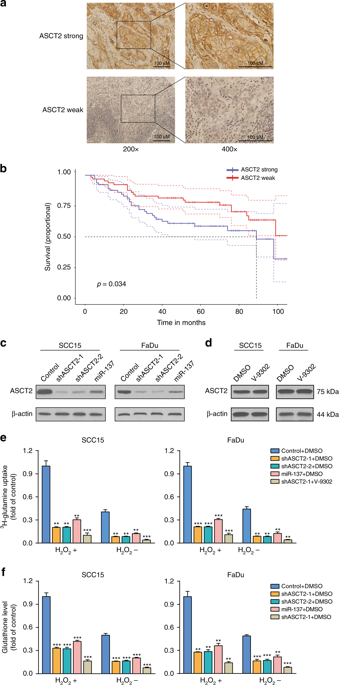当前位置:
X-MOL 学术
›
Br. J. Cancer
›
论文详情
Our official English website, www.x-mol.net, welcomes your
feedback! (Note: you will need to create a separate account there.)
ASCT2 (SLC1A5)-dependent glutamine uptake is involved in the progression of head and neck squamous cell carcinoma.
British Journal of Cancer ( IF 6.4 ) Pub Date : 2019-12-10 , DOI: 10.1038/s41416-019-0637-9 Ze Zhang 1 , Ruoyan Liu 2 , Yanjie Shuai 1 , Yuting Huang 3 , Rui Jin 1 , Xudong Wang 1 , Jingtao Luo 1
British Journal of Cancer ( IF 6.4 ) Pub Date : 2019-12-10 , DOI: 10.1038/s41416-019-0637-9 Ze Zhang 1 , Ruoyan Liu 2 , Yanjie Shuai 1 , Yuting Huang 3 , Rui Jin 1 , Xudong Wang 1 , Jingtao Luo 1
Affiliation

|
BACKGROUND
Glutamine is an abundant and versatile nutrient in cancer cells. Head and neck squamous cell carcinoma (HNSCC) was reported to be dependent on mainly glucose, not glutamine, for producing the energy required for survival and proliferation.
METHODS
The roles of ASCT2 (SLC1A5) and associated glutamine metabolism were determined by the MTT, colony formation, glutamine uptake, intracellular glutathione, ROS detection, immunofluorescence, immunohistochemistry, and apoptosis enzyme-linked immunosorbent assays as well as animal studies.
RESULTS
We found that glutamine is also critical for HNSCC. In this study, ASCT2, an amino acid transporter responsible for glutamine transport, in addition to LAT1 and GLS, is overexpressed in HNSCC and associated with poor survival. Using both in vivo and in vitro models, we found that knocking down ASCT2 by shRNAs or miR-137 or the combination of silencing ASCT2 and pharmacologically inhibiting SNAT2 via a small-molecule antagonist called V-9302 significantly suppressed intracellular glutamine levels and downstream glutamine metabolism, including glutathione production; these effects attenuated growth and proliferation, increased apoptosis and autophagy, and increased oxidative stress and mTORC1 pathway suppression in HNSCC. Additionally, silencing ASCT2 improved the response to cetuximab in HNSCC.
CONCLUSIONS
In summary, ASCT2-dependent glutamine uptake and subsequent glutamine metabolism are essential for HNSCC tumorigenesis, and the combination of glutamine uptake inhibitors and cetuximab presents a promising strategy for improving the outcomes of HNSCC patients.
中文翻译:

ASCT2 (SLC1A5) 依赖性谷氨酰胺摄取参与头颈部鳞状细胞癌的进展。
背景谷氨酰胺是癌细胞中丰富且用途广泛的营养素。据报道,头颈部鳞状细胞癌 (HNSCC) 主要依赖葡萄糖而不是谷氨酰胺来产生生存和增殖所需的能量。方法 通过 MTT、集落形成、谷氨酰胺摄取、细胞内谷胱甘肽、ROS 检测、免疫荧光、免疫组织化学和细胞凋亡酶联免疫吸附测定以及动物研究确定 ASCT2 (SLC1A5) 和相关谷氨酰胺代谢的作用。结果我们发现谷氨酰胺对 HNSCC 也很重要。在这项研究中,除了 LAT1 和 GLS 之外,负责谷氨酰胺转运的氨基酸转运蛋白 ASCT2 在 HNSCC 中过度表达并与较差的存活率相关。使用体内和体外模型,我们发现通过 shRNA 或 miR-137 敲低 ASCT2 或通过一种称为 V-9302 的小分子拮抗剂抑制 ASCT2 和药理学抑制 SNAT2 的组合显着抑制了细胞内谷氨酰胺水平和下游谷氨酰胺代谢,包括谷胱甘肽的产生;这些作用减弱了 HNSCC 的生长和增殖,增加了细胞凋亡和自噬,并增加了氧化应激和 mTORC1 通路抑制。此外,沉默 ASCT2 改善了 HNSCC 对西妥昔单抗的反应。结论 总之,ASCT2 依赖性谷氨酰胺摄取和随后的谷氨酰胺代谢对于 HNSCC 肿瘤发生至关重要,谷氨酰胺摄取抑制剂和西妥昔单抗的组合为改善 HNSCC 患者的预后提供了一种有前景的策略。
更新日期:2019-12-11
中文翻译:

ASCT2 (SLC1A5) 依赖性谷氨酰胺摄取参与头颈部鳞状细胞癌的进展。
背景谷氨酰胺是癌细胞中丰富且用途广泛的营养素。据报道,头颈部鳞状细胞癌 (HNSCC) 主要依赖葡萄糖而不是谷氨酰胺来产生生存和增殖所需的能量。方法 通过 MTT、集落形成、谷氨酰胺摄取、细胞内谷胱甘肽、ROS 检测、免疫荧光、免疫组织化学和细胞凋亡酶联免疫吸附测定以及动物研究确定 ASCT2 (SLC1A5) 和相关谷氨酰胺代谢的作用。结果我们发现谷氨酰胺对 HNSCC 也很重要。在这项研究中,除了 LAT1 和 GLS 之外,负责谷氨酰胺转运的氨基酸转运蛋白 ASCT2 在 HNSCC 中过度表达并与较差的存活率相关。使用体内和体外模型,我们发现通过 shRNA 或 miR-137 敲低 ASCT2 或通过一种称为 V-9302 的小分子拮抗剂抑制 ASCT2 和药理学抑制 SNAT2 的组合显着抑制了细胞内谷氨酰胺水平和下游谷氨酰胺代谢,包括谷胱甘肽的产生;这些作用减弱了 HNSCC 的生长和增殖,增加了细胞凋亡和自噬,并增加了氧化应激和 mTORC1 通路抑制。此外,沉默 ASCT2 改善了 HNSCC 对西妥昔单抗的反应。结论 总之,ASCT2 依赖性谷氨酰胺摄取和随后的谷氨酰胺代谢对于 HNSCC 肿瘤发生至关重要,谷氨酰胺摄取抑制剂和西妥昔单抗的组合为改善 HNSCC 患者的预后提供了一种有前景的策略。











































 京公网安备 11010802027423号
京公网安备 11010802027423号